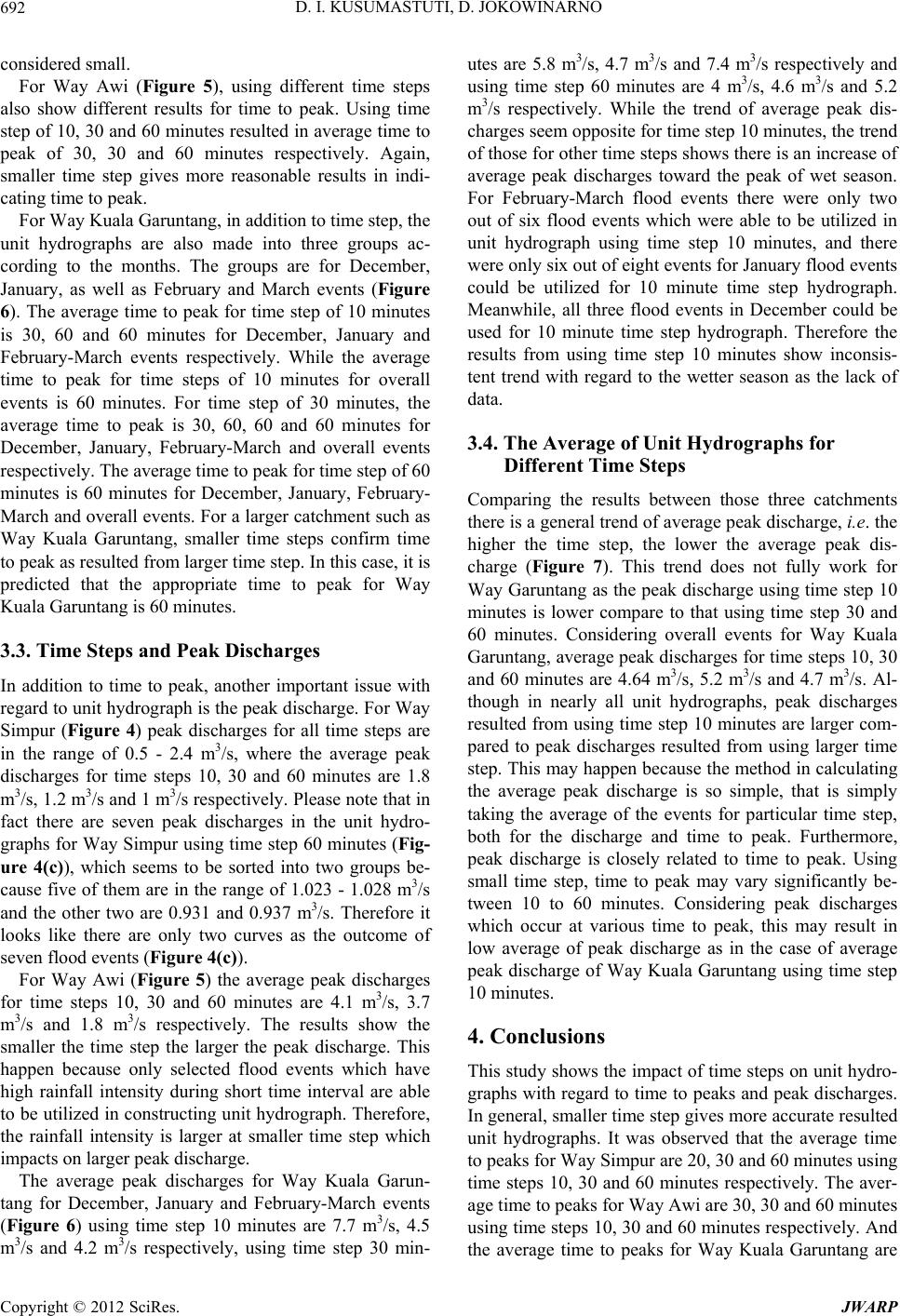
D. I. KUSUMASTUTI, D. JOKOWINARNO
692
considered small.
For Way Awi (Figure 5), using different time steps
also show different results for time to peak. Using time
step of 10, 30 and 60 minutes resulted in aver age time to
peak of 30, 30 and 60 minutes respectively. Again,
smaller time step gives more reasonable results in indi-
cating time to peak.
For Way Kuala Garuntang, in addition to time step, the
unit hydrographs are also made into three groups ac-
cording to the months. The groups are for December,
January, as well as February and March events (Figure
6). The average time to peak for time step of 10 minutes
is 30, 60 and 60 minutes for December, January and
February-March events respectively. While the average
time to peak for time steps of 10 minutes for overall
events is 60 minutes. For time step of 30 minutes, the
average time to peak is 30, 60, 60 and 60 minutes for
December, January, February-March and overall events
respectively. The average time to peak for time step of 60
minutes is 60 minutes for December, January, February-
March and overall events. For a larger catchment such as
Way Kuala Garuntang, smaller time steps confirm time
to peak as resulted from larger time step. In this case, it is
predicted that the appropriate time to peak for Way
Kuala Garu ntang is 60 minutes.
3.3. Time Steps and Peak Discharges
In addition to time to peak, another important issue with
regard to unit hydrog raph is the peak discharge. For Way
Simpur (Figure 4) peak discharges for all time steps are
in the range of 0.5 - 2.4 m3/s, where the average peak
discharges for time steps 10, 30 and 60 minutes are 1.8
m3/s, 1.2 m3/s and 1 m3/s respectively. Please note that in
fact there are seven peak discharges in the unit hydro-
graphs for Way Simpur using time step 60 minutes (Fig-
ure 4(c)), which seems to be sorted into two groups be-
cause five of them are in the range of 1.023 - 1.028 m3/s
and the other two are 0.931 and 0.937 m3/s. Therefore it
looks like there are only two curves as the outcome of
seven flood events (Figure 4(c)).
For Way Awi (Figure 5) the average peak discharges
for time steps 10, 30 and 60 minutes are 4.1 m3/s, 3.7
m3/s and 1.8 m3/s respectively. The results show the
smaller the time step the larger the peak discharge. This
happen because only selected flood events which have
high rainfall intensity during short time interval are able
to be utilized in con structing unit hydrograph. Therefore,
the rainfall intensity is larger at smaller time step which
impacts on larger peak discharge.
The average peak discharges for Way Kuala Garun-
tang for December, January and February-March events
(Figure 6) using time step 10 minutes are 7.7 m3/s, 4.5
m3/s and 4.2 m3/s respectively, using time step 30 min-
utes are 5.8 m3/s, 4.7 m3/s and 7.4 m3/s respectively and
using time step 60 minutes are 4 m3/s, 4.6 m3/s and 5.2
m3/s respectively. While the trend of average peak dis-
charges seem opposite for time step 10 minutes, the trend
of those for other time steps shows there is an increase of
average peak discharges toward the peak of wet season.
For February-March flood events there were only two
out of six flood events which were able to be utilized in
unit hydrograph using time step 10 minutes, and there
were only six out of eight even ts for January flood even ts
could be utilized for 10 minute time step hydrograph.
Meanwhile, all three flood events in December could be
used for 10 minute time step hydrograph. Therefore the
results from using time step 10 minutes show inconsis-
tent trend with regard to the wetter season as the lack of
data.
3.4. The Average of Unit Hydrographs for
Different Time Steps
Comparing the results between those three catchments
there is a general trend of average peak discharge, i.e. the
higher the time step, the lower the average peak dis-
charge (Figure 7). This trend does not fully work for
Way Garuntang as the peak discharge using time step 10
minutes is lower compare to that using time step 30 and
60 minutes. Considering overall events for Way Kuala
Garuntang, average peak discharges for time steps 10, 30
and 60 minutes are 4.64 m3/s, 5.2 m3/s and 4.7 m3/s. Al-
though in nearly all unit hydrographs, peak discharges
resulted from using time step 10 minutes are larg er com-
pared to peak discharges resulted from using larger time
step. This may happen because the method in calculating
the average peak discharge is so simple, that is simply
taking the average of the events for particular time step,
both for the discharge and time to peak. Furthermore,
peak discharge is closely related to time to peak. Using
small time step, time to peak may vary significantly be-
tween 10 to 60 minutes. Considering peak discharges
which occur at various time to peak, this may result in
low average of peak discharge as in the case of average
peak discharge of Way Kuala Garuntang using time step
10 minutes.
4. Conclusions
This study shows the impact of time steps on un it hydro-
graphs with regard to time to peaks and peak discharges.
In general, smaller time step gives more accurate resulted
unit hydrographs. It was observed that the average time
to peaks for Way Simpur are 20, 30 and 60 minutes using
time steps 10, 30 and 60 minutes respectively. The aver-
age time to peaks for Way Awi are 30, 30 and 60 minutes
using time steps 10, 30 and 60 minutes respectively. And
he average time to peaks for Way Kuala Garuntang are t
Copyright © 2012 SciRes. JWARP